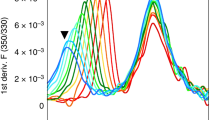Abstract
INFECTION by influenza virus results in the stimulation of cytotoxic T lymphocytes specific for killing virally infected cells1. Specificity is provided by clonally distributed, hypervariable T-cell receptors on cytotoxic T lymphocytes which react with peptide fragments that are derived from viral proteins expressed in the cytoplasm and 'presented' on the surface of infected cells, bound to class I histocompatibility glycoproteins2. Here we describe the structure of the complex between the human class I histocompatibility glycoprotein HLA-Aw68 and the influenza virus nucleoprotein peptide Np 91–99 as determined by X-ray cryo-crystallography. Residues at both ends of the peptide are substantially buried in the peptide binding-site, whereas those in the middle of the peptide, P4 to P8, are predominantly exposed and could be recognized directly by T-cell receptors. The extended conformation of the bound viral peptide is remarkably similar to that of a collection of endogenous peptides with a different sequence motif bound to another human allele, HLA-B273–5. The structure defines in atomic detail the antigenic surface constructed of major histocompatibility complex and viral peptide atoms that is recognized by T-cell receptors.
This is a preview of subscription content, access via your institution
Access options
Subscribe to this journal
Receive 51 print issues and online access
$199.00 per year
only $3.90 per issue
Buy this article
- Purchase on Springer Link
- Instant access to full article PDF
Prices may be subject to local taxes which are calculated during checkout
Similar content being viewed by others
References
Townsend, A. & Bodmer, H. A. Rev. Immun. 7, 601–624 (1989).
Brodsky, F. M. & Guagliardi, L. E. A. Rev. Immun. 9, 707–744 (1991).
Madden, D. R., Gorga, J. C., Strominger, J. L. & Wiley, D. C. Nature 253, 321–325 (1991).
Jardetzky, T. S., Lane, W. S., Robinson, R. A., Madden, D. R. & Wiley, D. C. Nature 253, 326–329 (1991).
Madden, D. R., Gorga, J. C., Strominger, J. L. & Wiley, D. C. Cell 70, 1035–1048 (1992).
Turner, M. J. et al. J. biol. Chem. 250, 4512–4519 (1975).
Bjorkman, P. J., Strominger, J. L. & Wiley, D. C. J. molec. Biol. 186, 205–210 (1986).
Silver, M. L., Parker, K. C. & Wiley, D. C. Nature 350, 619–622 (1991).
Cerundolo, V., Tse, A. G. D., Salter, R. D., Parham, P. & Townsend, A. Proc. R. Soc. 244, 169–177 (1991).
Guo, H. C., Jardetzky, T. S., Lane, W. S., Strominger, J. L. & Wiley, D. C. Nature 360, 364–366 (1992).
Garrett, T. P. J., Saper, M. A., Bjorkman, P. J., Strominger, J. L. & Wiley, D. C. Nature 342, 692–696 (1989).
Saper, M. A., Bjorkman, P. J. & Wiley, D. C. J. molec. Biol. 219, 277–319 (1991).
Fremont, D. H., Matsumura, M. Stura, E. A., Peterson, P. A. & Wilson, I. A. Science 257, 919–927 (1992).
Teng, T-Y. J. appl. Crystallogr. 23, 387–391 (1990).
Durbin, R. M. et al. Science 232, 1127–1132 (1986).
Blum, M., Metcalf, P., Harrison, S. C. & Wiley, D. C. J. appl. Crystallogr. 20, 235–242 (1987).
Fox, G. C. & Holmes, K. C. Acta Crystallogr. A34, 517 (1966).
Brünger, A. T. XPLOR (version 2.1) Yale University, New Haven, (1990).
Silver, M. L. thesis, Harvard University (1992).
Jones, T. A. J. appl. Crystallogr. 11, 268–272 (1978).
Parham, P. et al. Proc. natn. Acad. Sci. U.S.A. 85, 4005–4009 (1988).
Johnson, C. K. ORTEP Manual (Oak Ridge National Laboratory, Tennessee, 1965).
Bjorkman, P. J. et al. Nature 329, 512–518 (1987).
Zhang, W., Young, A. C. M., Imarai, M., Nathenson, S. G. & Sacchettini, J. C. Proc. natn. Acad. Sci. U.S.A. 89, 8403–8407 (1992).
Author information
Authors and Affiliations
Rights and permissions
About this article
Cite this article
Silver, M., Guo, HC., Strominger, J. et al. Atomic structure of a human MHC molecule presenting an influenza virus peptide. Nature 360, 367–369 (1992). https://doi.org/10.1038/360367a0
Received:
Accepted:
Issue Date:
DOI: https://doi.org/10.1038/360367a0
This article is cited by
-
Thymoproteasomes produce unique peptide motifs for positive selection of CD8+ T cells
Nature Communications (2015)
-
The ultimate mix and match: making sense of HLA alleles and peptide repertoires
Immunology & Cell Biology (2015)
-
Nucleoprotein of influenza A virus is a major target of immunodominant CD8+ T‐cell responses
Immunology & Cell Biology (2013)
-
POPISK: T-cell reactivity prediction using support vector machines and string kernels
BMC Bioinformatics (2011)
-
HLA class I supertypes: a revised and updated classification
BMC Immunology (2008)
Comments
By submitting a comment you agree to abide by our Terms and Community Guidelines. If you find something abusive or that does not comply with our terms or guidelines please flag it as inappropriate.



